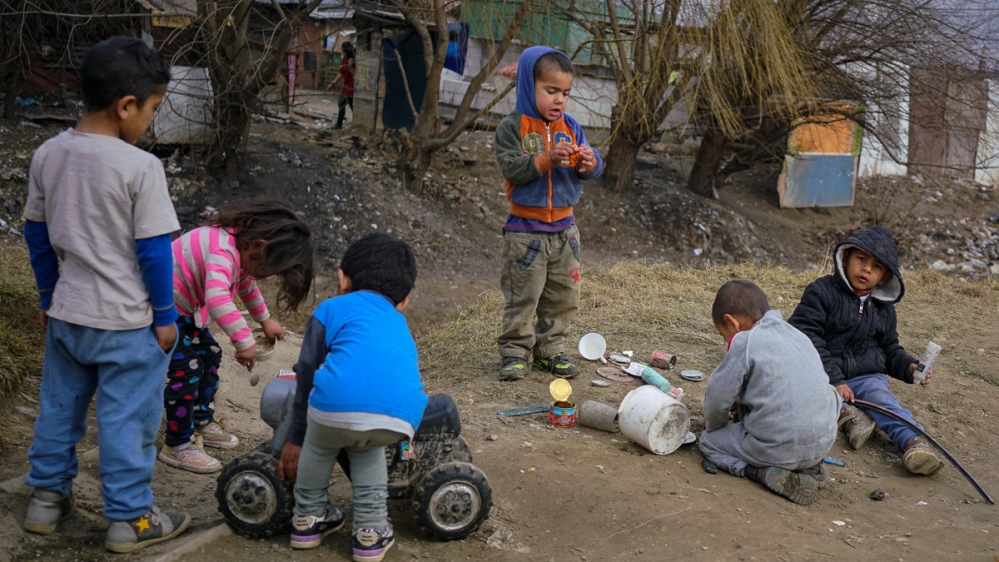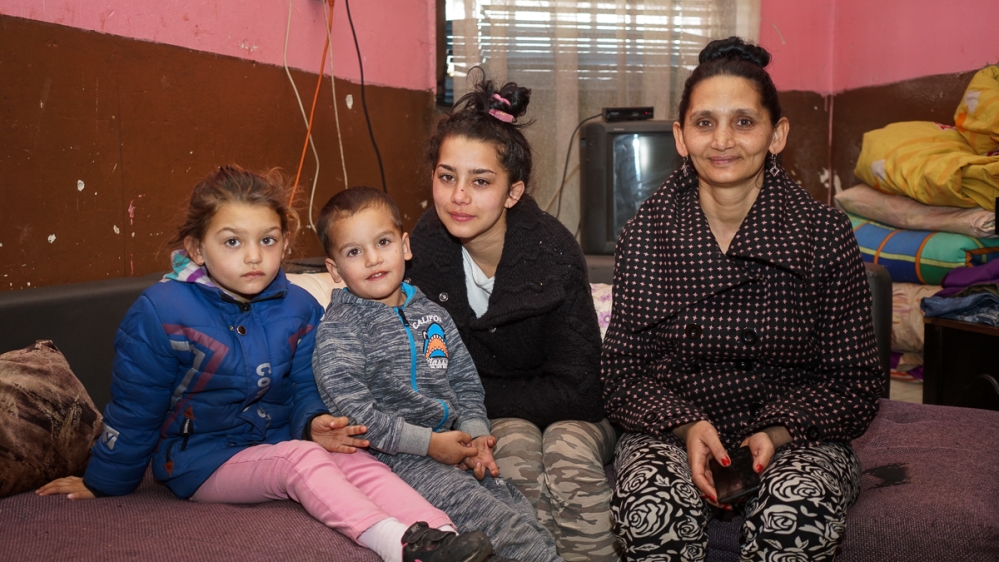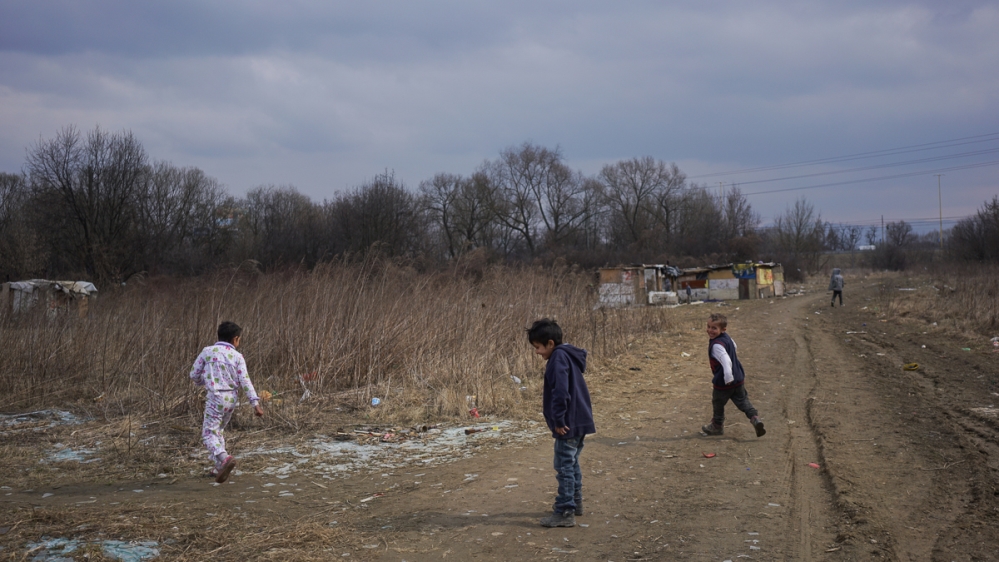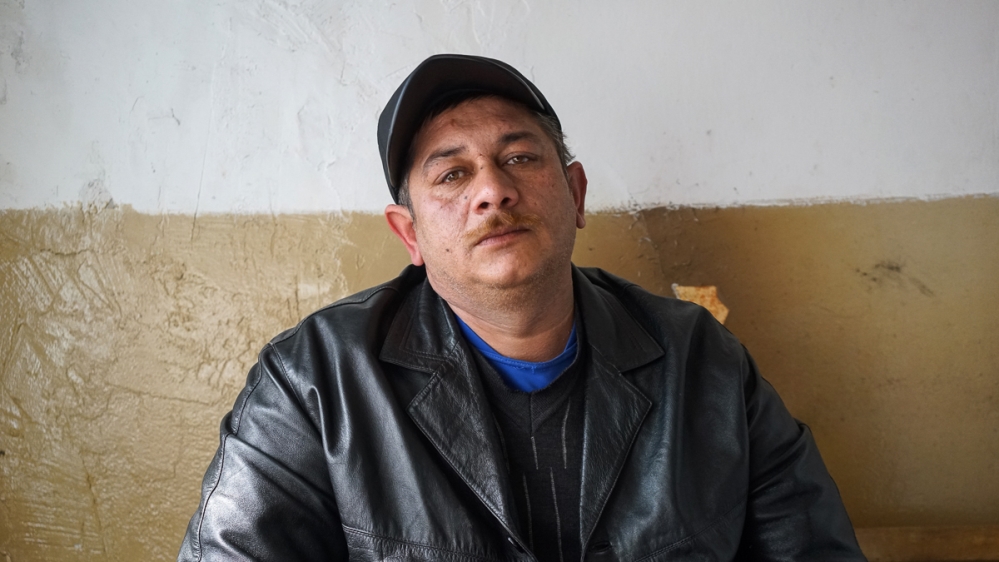Life in Slovakia’s Roma Slums: Poverty and Segregation
EXPOSURES - EXPOSÉS, BALKANS AND EASTERN EUROPE, EUROPE, 15 May 2017
Patrick Strickland – Al Jazeera
Institutional racism, unemployment and poor housing are among the hardships endured by Slovakia’s half-a-million Roma.
10 May 2017– Slipshod huts and sagging shacks line both sides of the quiet river that bisects the densely populated Roma slum in the centre of Jarovnice, an impoverished village in the Sabinov district of eastern Slovakia.
On a cold morning in March, speeding cars bounce along muddy paths, drivers navigating one pothole after another and dodging children who have nowhere to play but the streets.
A rickety steel bridge connects the two sides of the slum and serves as a meeting place for children returning from school.
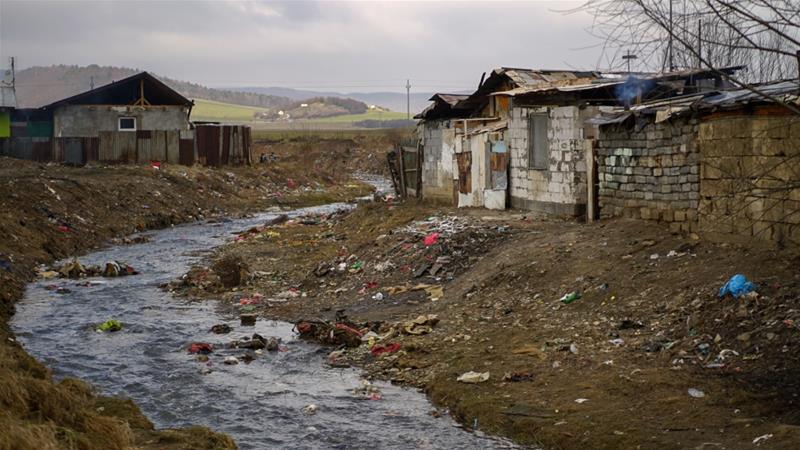
The Roma slum in Jarovnice, Slovakia, is home to an estimated 5,600 people. [Sorin Furcoi/Al Jazeera]
Martin Kaleja Januv, a 33-year-old teaching assistant, is one of the few residents of Jarovnice with a paying job. The Roma population’s 97 percent unemployment rate renders most locals entirely dependent on welfare, according to the local municipality’s estimates.
Of the village’s estimated 6,548 residents, more than 5,600 are Roma who live in the slum, which covers less than a square kilometre.
“The worst part is the lack of privacy,” says Martin, who lives with his wife, father-in-law and three children in a two-room home on a tiny, grassless lot shared with other homes and shacks. “If I could afford it, I’d live somewhere else. Not just for me, but for my kids.”
His family is among the few lucky ones. Built without permits, many homes house between eight and 10 people and lack electricity, water and gas.
“We are trying to save some money to buy something outside the settlement,” he says, explaining that he makes around 300 euros (about $327) a month. “But every time we save up a little money, something unexpected happens and we spend it.”
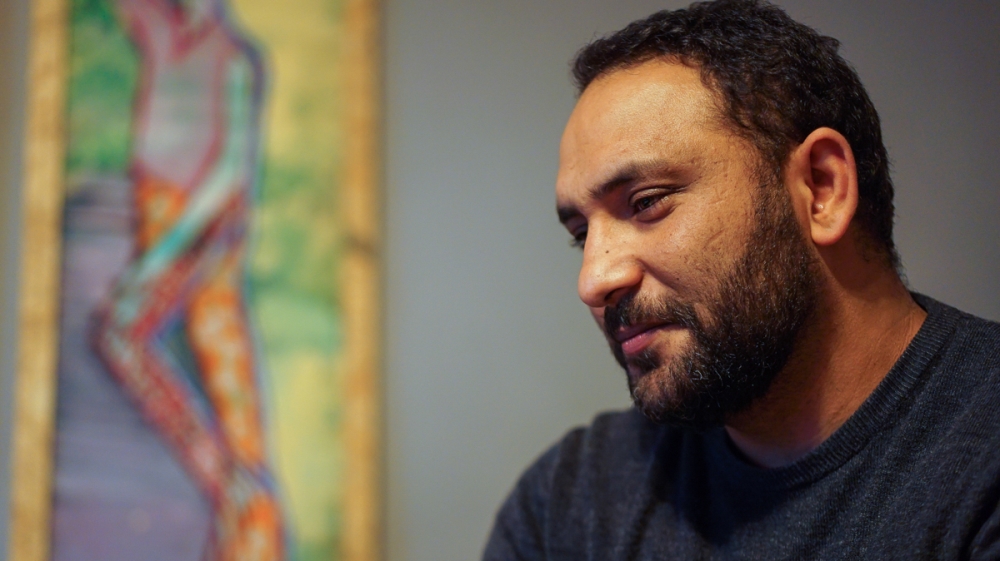
Martin Kaleja Januv is one of the few people in the Roma slum in Jarovnice with a paying job. He is trying to save enough money to buy his family a house outside of the slum, but it isn’t easy. [Sorin Furcoi/Al Jazeera]
Growing up in Jarovnice, he says his childhood was punctuated with racist insults and systemic discrimination. “When I used to travel to school on the bus, they [white Slovaks] would call us smelly. When we go to the store, they watch us like we’re going to steal,” he says, shaking his head.
Numbering half a million and making up an estimated 10 percent of Slovakia’s population, Roma are the second-largest ethnic minority in the country.
According to a November 2014 policy paper by the Institute for Financial Policy, nearly 40 percent of the adult Roma population existed entirely outside the labour market, as compared with 24 percent of non-Roma. Those who can work often do so in the black market. Citing widespread discrimination and low education levels, the paper found that the employment rate of Roma aged 15 to 64 sat at 17 percent.
In Jarovnice, Martin says, life “just keeps getting worse and worse. It’s overcrowded, and people really don’t have a chance to develop themselves here”.
“There is no escape. We can’t get jobs … [that pay] enough money to buy something or move somewhere else,” he adds. “Everyone says Roma cannot adapt themselves to the country’s way of life and abuse the social system and take money. But this money is so little that you can’t live from it. Even my salary is small.”
According to the European Roma Rights Centre (ERRC), Roma in Slovakia endure racism in the job market, housing and education fields and are often subjected to forced evictions, vigilante intimidation, disproportionate levels of police brutality and more subtle forms of discrimination.
Jonathan Lee, the centre’s communications officer, says no Slovak government since the 1989 fall of communism has “taken seriously Roma’s problems” or combated anti-Roma racism.
Although comprehensive statistics are unavailable, he says that there has been a general increase in anti-Roma hate crimes since 2008 and that segregation has continually worsened, alluding to at least eight segregation walls dividing Roma and non-Roma communities in the eastern city of Kosice alone.
And discriminatory rhetoric is as prevalent among liberal and centrist politicians as it is on the far-right, he says, explaining: “Roma are a popular scapegoat for politicians in Bratislava to gain votes while playing to a deeply prejudiced society.
“Within Slovakia more than other countries, hate speech has become so normalised by mainstream politicians that it’s hard to differentiate between the far right and others [in respect to Roma].”
History of deprivation
The history of Jarovnice’s Roma, who settled in the area hundreds of years ago, is dotted with unfulfilled promises – and poverty and institutional deprivation have more than once had tragic consequences here.
On July 20, 1998, heavy rains pounded the village. Within an hour, the river’s water rose drastically. Fifty-two people died and more than 170 homes were destroyed in floods.
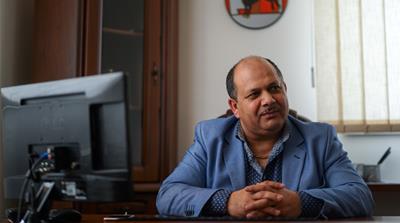
When Roma Florian Gina became mayor seven years ago, some Slovak locals tried to create a separate municipality.
[Sorin Furcoi/Al Jazeera]
For Mayor Florian Gina, who became one of dozens of Roma mayors in Slovakia when he attained office in 2010, the floods were a microcosm of the Roma minority’s life. Against a backdrop of persecution and systemic racism, the state has viewed their communities’ ills as tangential concerns at best, he believes.
Sitting in his office, the mayor remembers the floods with anger. As poor families raised what little they could to bury their dead, state officials and politicians visited Jarovnice to promise safer housing and a solution to the problems plaguing the slum and others like it. “But,” he says, “they did nothing”.
READ MORE: Slovakia’s government failing to educate, integrate Roma children
After he was elected seven years ago, white Slovak locals, angered by a Roma holding office in their village, circulated a petition to create a separate municipality.
Born and raised in Jarovnice’s slum, where he still lives with his family, Florian estimates that the village has one of the most densely populated Roma populations per capita in Europe and suspects that at least 900 unregistered residents live in the slum uncounted.
Getting up from behind his desk, he points to several spots on a map of the village, explaining where Jarovnice’s Roma population lives in relation to the 900-person white population surrounding the slum.
Florian guesses that around half of the homes do not have water or electricity owing to their lack of permits. “Our state doesn’t care about [Roma] people. The [national] government … doesn’t care about simple people living in these regions,” he says.
Referring to the 1989 uprising that led to the collapse of the Czechoslovak communist government and the establishment of the Slovak Republic, he says: “It’s been 26 years since the revolution, there’s been no change and they’ve solved nothing with the Roma community living here.”
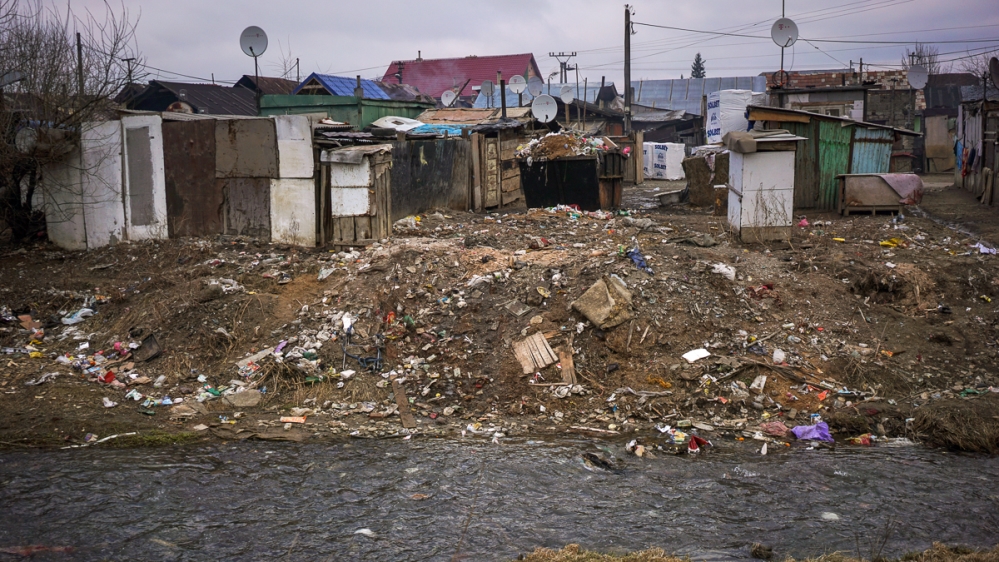
The river that flooded in 1998, destroying more than 170 homes in the slum and killing 52 people.
[Sorin Furcoi/Al Jazeera]
‘We can’t afford anything else’
On a hilltop at the end of a cul-de-sac is the slum’s church, its doors locked apart from on Sunday mornings or during bible study meetings on Wednesdays. Down the path are homes pieced together with spare wood, scrap metal, cinder blocks and an occasional cardboard panel.
Jan Carny, 58, and his wife Darina stand with some neighbours in front of a burned-out sedan. They smoke cigarette after cigarette and greet each passer-by. There are no pavements so they saunter along muddy paths back to their home. Bursts of pop music occasionally interrupt their conversation as cars pass by. A sullen dog stands on alert for a moment, before losing interest and retreating to the doghouse to which it is chained. Laundry dances in the wind on a line behind it.
Back in their kitchen, Darina opens the door of the oven to let the warmth circulate through the home. Jan takes a seat, lights a cigarette and stirs a mug of instant coffee.
Their home on the river bank has two rooms and a kitchen. They share it with their son, daughter-in-law and two grandchildren.
The couple had three sons and three daughters, but they lost two of the girls during childhood – one to a brain disorder at three months and the other to pneumonia at the age of seven.
Explaining that he has “either 15 or 16 grandkids”, Jan says all his surviving children, who are now adults, are unemployed.
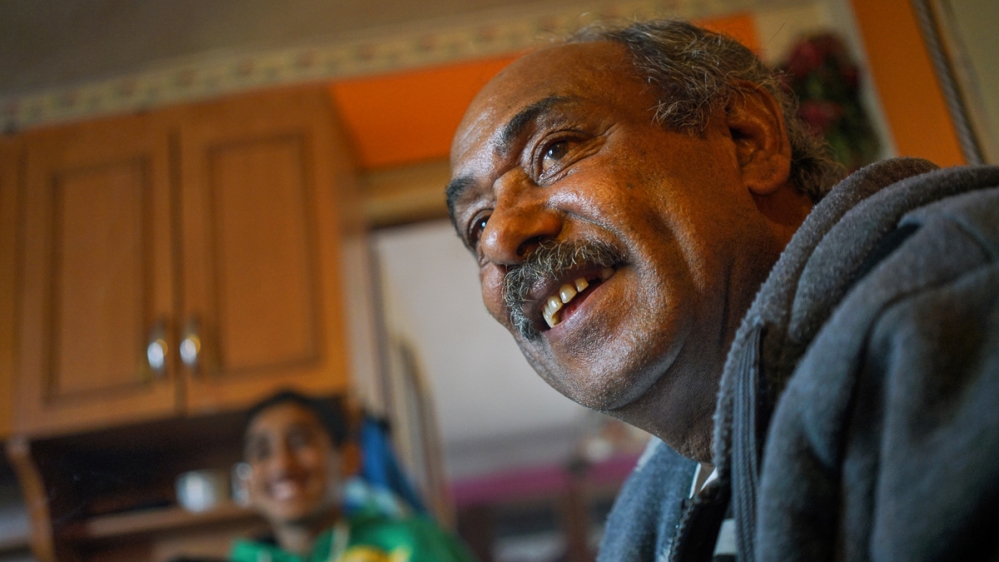
Jan Carny lives in the slum with his wife, son, daughter-in-law and two of his “15 or 16 grandkids”. [Sorin Furcoi/Al Jazeera]
Due to asthma and other respiratory complications, he no longer works and relies on a 120 euro (around $130) welfare cheque to make it through the month, along with Darina’s 300 euro ($327) income from a part-time factory job. After spending an average of 170 euros (about $185) on his medicine, electricity and Darina’s transport to work, they have just enough left over for food for the household. “We can’t afford anything else,” he says.
A painting of the Virgin Mary hangs on the wall behind Jan. Having only completed primary schooling, he has never had many employment opportunities: an odd job nearby or a construction gig elsewhere in the country punctuate long stretches of unemployment.
If he had been a more frequent drinker, Jan reflects, he wouldn’t have been able to eventually get this home for his family. “A lot of men here have fridges full of alcohol,” he says. “I was only able to build a house and take care of my family because I didn’t drink at home. I only drank with white people when we were at work, but never at home.”
‘Burn the books to stay warm’
Jozef Bugna, the 61-year-old director of the local primary school, has taught physical education for the past 34 years. When he first started, there were still white Slovak pupils at the school. But in 1992, white families campaigned to get their own schools. At the time about a quarter of the 400 pupils were Roma; today there more than 1,000 pupils – and all of them are Roma.
A short man with a thick mustache, he jokes frequently and gesticulates as he speaks. He lost the drive to make a change years ago, he confesses.
The school director estimates that 75 to 85 percent of his pupils come from impoverished families, with many lacking a stable home environment. To be eligible for welfare, pupils must complete nine years of school. Around 110 pupils completed the ninth-grade last year. Of that total, 15 were pregnant by the time the school year finished and only eight or nine went on to secondary school.
“So, we see that students want to learn and improve their situation, but they start losing interest at around 14 and 15,” he says. “The number of those who will go on to find jobs – zero.”
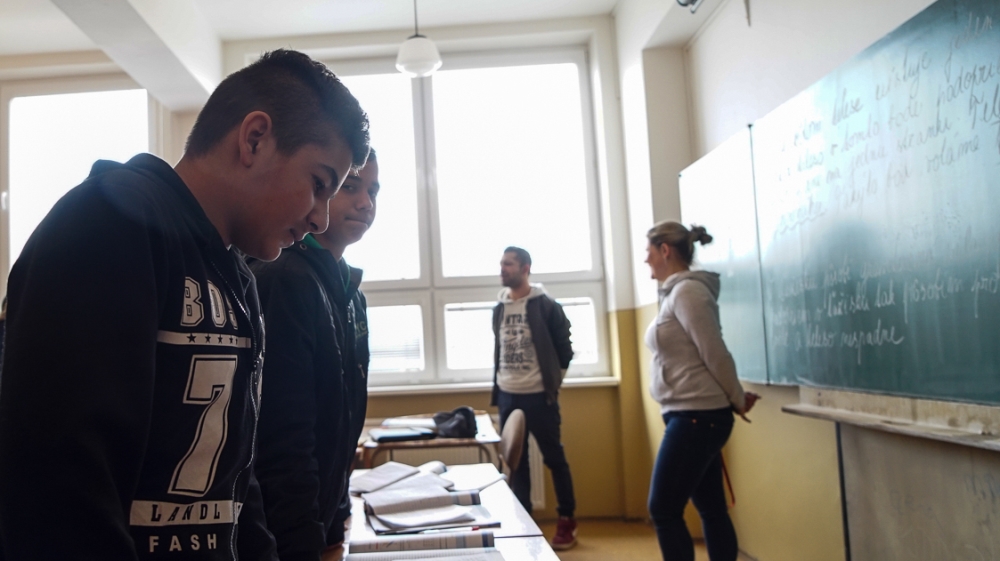
The director of the local primary school says that between 75 and 85 percent of the children at the school come from impoverished families. [Sorin Furcoi/Al Jazeera]
“The Nobel Prize could be granted to the person who solves the problems here. Many people say they’re experts on the problems facing Roma, but I’ve never met anyone with an answer,” the school director adds.
The poverty that limits Roma children’s opportunities appears to be a symptom of an even more entrenched disease: racism. There are no Roma teachers at the school and only three Roma teaching assistants.
READ MORE: Thousands of Roma ‘made homeless’ in France in 2016
In a recent report, the ERRC and Amnesty International found that Roma children are sometimes segregated, bullied by teachers and incorrectly diagnosed as intellectually disabled due to the pervasive anti-Roma racism in Slovakia. The rights groups accused Slovakia of systematically denying Roma pupils their rights and thus trapping them “in a cycle of poverty and marginalisation”.
That report stated that “interviews with school teachers revealed very troubling and widespread discriminatory attitudes and low expectations regarding Roma”.
Citing the State School Inspectorate, a government-run monitor, it noted that more than a fifth of Roma pupils had been subjected to derogatory language, including anti-Roma slurs, by teachers.
To make matters worse, schools in places such as Jarovnice often prohibit Roma pupils from taking their textbooks home with them, rendering it much more difficult to study outside of the classroom.
According to ETP Slovakia, a nonprofit organisation that works with Roma in the east of the country, many Roma pupils finish their school day and return to homes with little food, no running water and no heat. Others regularly fall ill with hepatitis, tuberculosis and other ailments due to a lack of vaccinations and poor sanitation. Some regularly return to new housing situations as their families are evicted from unlicensed homes and end up in yet more dangerous shantytowns.
“Some of them don’t have tables or even anywhere to sit and write their homework, and most of the schools don’t allow them to take their schoolbooks home because they burn them to keep warm in the winter,” says Michaela Csalova, of ETP Slovakia.
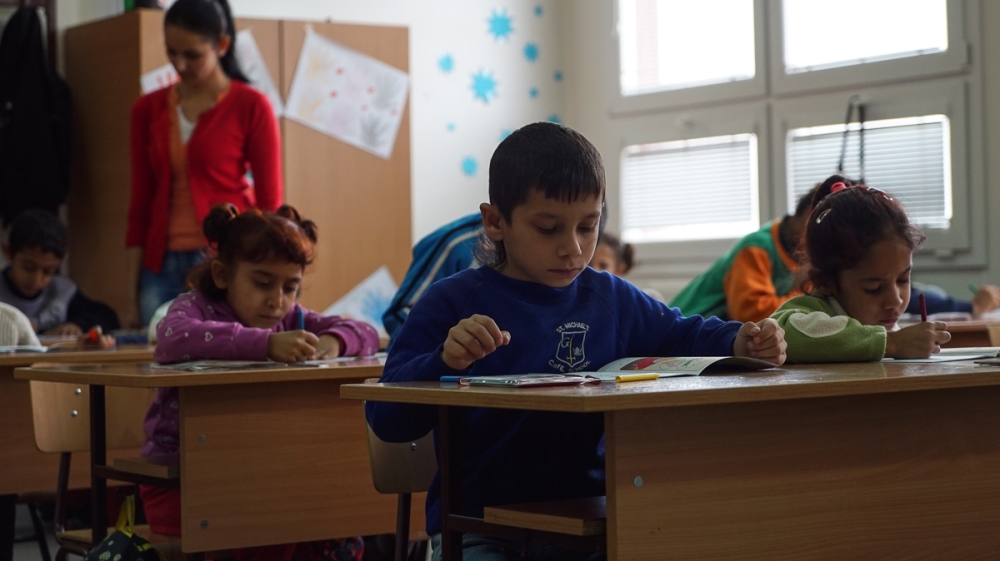
Most schools do not allow Roma children to take their textbooks home with them, in case they are used to make fires during the winter in homes that have no heating.
[Sorin Furcoi/Al Jazeera]
She explains that white Slovak communities usually have kindergartens, while the overwhelming majority of Roma communities, which have access to far fewer public resources, do not. By starting their schooling later than other Slovaks and often only able to speak the Romani language, Roma pupils are immediately disadvantaged.
“The teachers say the students cannot be educated, but they are not allowing them to be educated,” Michaela adds. “At school, they don’t really have an individual approach towards [pupils] and there are no books or anything at home. How can you improve?”
Lunik IX: Poverty and white flight
An hour’s drive south of Jarovnice is Kosice, the country’s second-largest city. The streets of the city centre are lined with cafes, bars and souvenir shops. Across from luxury hotels are historic cathedrals, Gothic chapels and a subterranean archeological museum.
But a 10-minute drive away, on Kosice’s outskirts, is Lunik IX, a Roma slum that is home to between 4,500 and 6,000 people. In the early 1980s, the communist government built several of the housing blocks here for military families. They have since begun to crumble. Their white residents have moved out, but poor Roma remain.
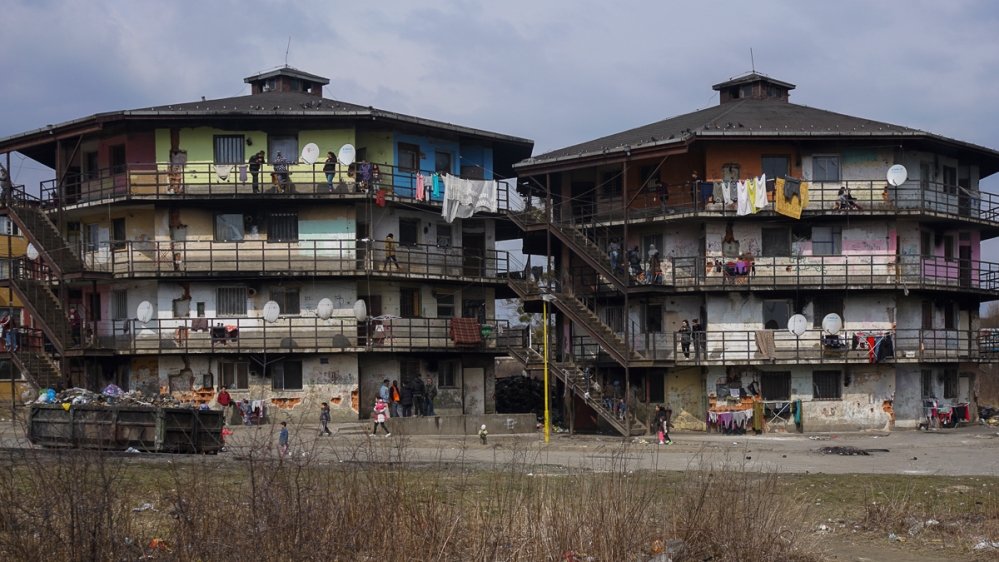
Built to house military families in the early 1980s, these apartment blocks on the outskirts of Kosice are now home to poor Roma families. [Sorin Furcoi/Al Jazeera]
Vojtech Horvath, a 43-year-old husband and father of eight, moved to Lunik IX when he was seven years old.
“It was very nice when we first moved here. There were some other Roma people, but I also remember we played with white kids. It wasn’t like now – there wasn’t so much discrimination or feeling that white people didn’t want to interact with us [Roma],” he says, explaining that the conditions worsened over time and describing the community as a “ghetto”.
Vojtech walks through the streets of Lunik IX, flicking his cigarette and waving to those he passes. He eventually arrives at a multi-coloured, hexagonal, three-storey apartment building nicknamed “Corn” by its residents. A few teenagers sit on the stairs, huddled around a mobile phone, watching a music video on YouTube.
Vojtech, who is unemployed but volunteers for a city-run vaccination awareness programme, lives with his wife and seven of his eight children in a one-room flat.
Once inside, he moves the furniture to show how they create enough space for them all to sleep. Unfolding part of the sofa into a small bed, he explains that three children sleep there. He moves a small kitchen table in the living room to reveal two teenagers sitting on blankets on the floor. His two youngest children sleep with him and his wife on a bed on a second-floor gallery.
There is water damage on the ceiling and small cracks through which water leaks during heavy rain.
His oldest daughter lives with her husband and children in a neighbouring building.
Although he mostly relies on welfare to keep his family afloat, he sometimes finds an occasional day job to earn a little extra money.
Sixty euros (about $66) of the 420 euros (about $459) in welfare payments the family receives each month go towards rent. Although the building is owned by the city and he says he always pays his rent, he must also pay his neighbour around 20 euros (about $22) a month to allow him to use a few hours of electricity each day. He sends his children to fetch water from neighbours or a nearby well.
Despite access to water being enshrined in law as a human right by the United Nations, the European Union and the Council of Europe, Roma in both EU and non-EU states often struggle to obtain running, potable water, according to another recent report by the ERRC. That report – Thirsting for Justice – found that Roma are “often treated differently and discriminated against by local authorities when it comes to the provision of” safe and secure access to water and sanitation.
“Their water sources are often far from home, with the burden to secure water falling disproportionately on women and girls,” the report explains. “These sources are frequently not tested to ensure their safety and are exposed to a wide range of contaminants, including dry toilets [pit latrines], insects and wild animals.”
To make his welfare payments last the month, Vojtech must crunch numbers and decide which are the most necessary necessities. He spends 100 euros ($109) a month on food – less than 12 euros per person. “When you don’t have much money, you know what to buy to make it last,” he explains. “Maybe Roma get more money in other countries, but Slovakia is poor.”
Hoping to eventually escape the overcrowding and poverty that characterise daily life in Lunik IX, he puts 50 euros (about $55) a month into a savings account as part of ETP Slovakia’s housing programme. Once he reaches 2,000 euros ($2,184), the NGO will provide him with a microloan of 9,000 euros ($9,826) to build a home in a small planned community nearby.
Searching for an escape
Vojtech says that he has lost any hope that Slovakia’s politicians will do anything to improve life in the slum. “There’s never any change, nothing. They [officials] come here before elections and say they’ll fix the situation, but nothing happens,” he says. “Journalists and politicians say Lunik is a place you can enter and be killed. It’s not true. People should come and see that we’re normal. There’s just no playground for our kids and the living conditions are bad.”
Asked what he hopes for, he replies simply: “I don’t have any hopes for myself beyond having a house, but I want a better life for my children. If I have a house, I may go but it will remain with them.”
Stories like Vojtech’s are common throughout Lunik IX. Kristína Fercakova, a 38-year-old mother of eight who lives in a neighbouring apartment block, has also applied to the ETP programme to obtain a house in a planned community. “We can’t always afford electricity,” she says. “There is no heating even in the winter, and it’s very cold.”
Her 20-year-old daughter Zuzana, who recently returned from working in the United Kingdom with little money to show for it, stands in the living room and gently rocks her baby. She explains that many Lunik IX residents leave the country to search for work elsewhere in the EU due to the racism they endure while looking for jobs at home. “When we call about a job opening, they say, ‘Yes, it’s open’,” she notes. “But when you show up and they see you’re a [Roma], they just say it’s already been filled.”
The Ministry of Labour did not reply to Al Jazeera’s requests for a comment on allegations of widespread discrimination against Roma in the employment market.
Hundreds of Roma who used to live in a tower at Lunik IX have spent the past three years living in the adjacent field, where a settlement nicknamed Maslickovo has popped up. Evicted by authorities who deemed their apartment complex too dangerous to live in, those who were behind on rent or had outstanding debts were not provided with alternative housing.
On a chilly afternoon, a man sits in front of his shack – made of sheet metal, cardboard and scrap wood – as his dog rests on the damp ground beside a small pile of rubbish that has been set alight to make a fire for coffee. A few dozen metres away, Iveta Fercakova sweeps rubbish from the muddy patch in front of her makeshift doorway.
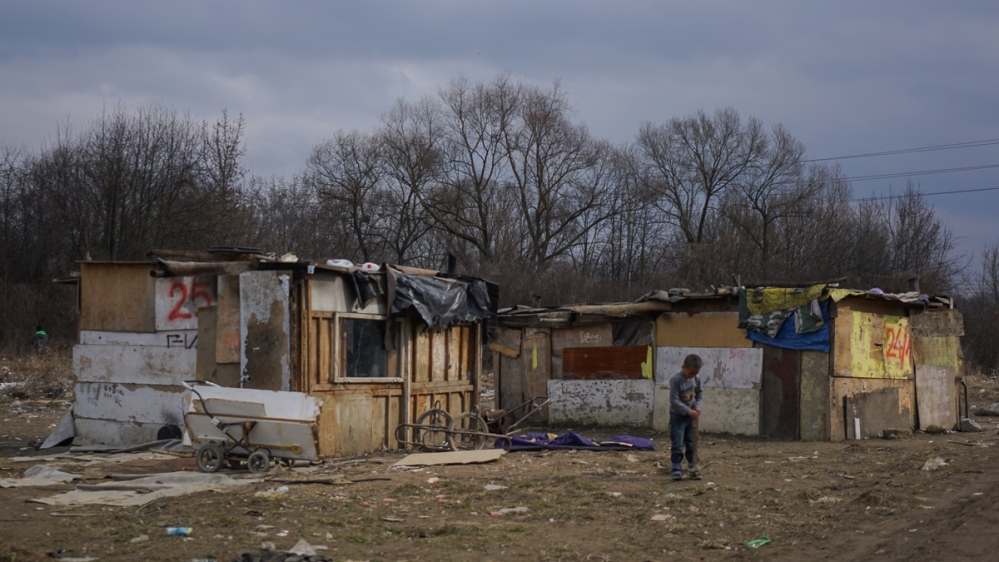
When residents of one building in Lunik IX were evicted because the premises were deemed too dangerous to live in, those who were in rent arrears were not rehoused. They have spent the past three years living in shacks on an adjacent field. [Sorin Furcoi/Al Jazeera]
The mother of six, who thinks she is in her 50s, ended up in Maslickovo after their home was demolished in Lunik IX. “My daughter’s [two] children were taken [by authorities] this winter,” she says, distraught as she recalls how dozens of children were taken into state custody after social workers visited the impromptu community as temperatures plummeted during the winter months.
Lydia Gall, a researcher for Human Rights Watch, says the housing problems Roma in Slovakia endure are common in several countries in the EU. Because Roma communities in Slovakia and elsewhere are often irregular and lack permits, authorities can evict residents without alternative housing options, creating yet more slums. “They are at the constant mercy of authorities who could show up at any given point and vacate the area,” she says.
Far-right intimidation
On the fifth floor of an apartment block, accessed via an unlit stairwell, Zuzana’s 43-year-old uncle, Ondrej Fercack, lives with his wife, Svetlana, and their seven children in a two-room flat.
Clean shaven save for a bushy mustache, Ondrej says the hardships of poverty are amplified by racist taunts and intimidation many Roma endure while navigating daily life in the city. Svetlana tends to soup on the stove while her husband sits at the kitchen table and recalls being regularly approached by supporters of the far-right Kotleba – People’s Party Our Slovakia (LSNS) during trips to the grocery store.
In March 2016, LSNS shocked the country’s mainstream establishment when it gained eight percent of the popular vote and secured 14 seats in the National Council. The party’s leader and namesake, Marian Kotleba, has been governor of the Banska Bystrica region since November 2013.
The party embraces neo-fascist rhetoric and idolises Jozef Tiso, the leader of the First Slovak Republic between 1939 and 1945. Tiso, who was also a Catholic priest, turned the country into a Nazi satellite state and cooperated with Hitler’s regime by deporting an estimated 70,000 Jews to labour and concentration camps. Historians believe Germans murdered around 60,000 of those evicted from Slovakia.
Today, Kotleba and his party harbour an especially vitriolic hatred for Roma, who Kotleba members regularly refer to as “social parasites” and “extremists”, accusing them of being responsible for crime and many of the country’s economic woes. The LSNS political platform says that the party “will put a stop to the preferential treatment of all social parasites, including gypsy parasites”.
It continues: “Parasites who will refuse to work, will receive nothing for free – no housing or other benefits and allowances.”
In October 2016, the Slovak parliament outlawed vigilante patrols by LSNS members that targeted Roma passengers on trains. Donning the party’s signature green shirts, the vigilantes would board trains and intimidate Roma, often hurling racist slurs and threats at them.
OPINION: Why are Roma blamed for Europe’s rejection of refugees?
“No one can replace the police in this country, and no one should act like it either,” Justice Minister Lucia Zitnanska told the local TASR news agency at the time. Nonetheless, LSNS vowed to continue the patrols despite the parliament’s decision.
Alena Krempaska, programme director of the Bratislava-based Human Rights Institute, says that the LSNS “tries to portray themselves as having nothing to do with violence”, all while holding vigilante patrols on trains and in and around Roma communities.
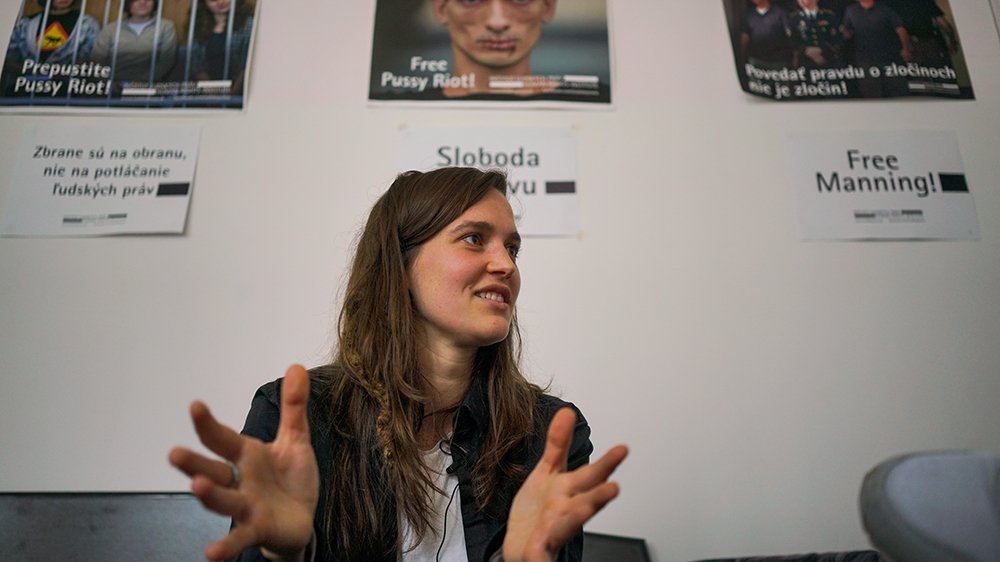
Alena Krempaska is the programme director of the Bratislava-based Human Rights Institute.
[Sorin Furcoi/Al Jazeera]
“They even produce fake stories,” about alleged Roma violence, she says, arguing that their anti-Roma rhetoric constitutes incitement to violence. “It’s not an accident that we call them a neo-Nazi party. They really come from a neo-Nazi background … They incite a general atmosphere of hatred against Roma people [and other minority groups].”
Folding his hands on the kitchen table, Ondrej blames Prime Minister Robert Fico and the ruling party, Direction – Social Democracy (SMER-SD), for not standing up to anti-Roma racism. “When they [the LSNS] speak about us, they say racist things,” he argues. “It creates negative public sentiment against Roma in Slovakia. Our prime minister does nothing about … the fascists.”
Fico has used derogatory language when speaking of Roma in the past, referring to them as “gypsies” and accusing them of “abusing” the welfare system in February. At the time of publication, the prime minister’s office had not replied to Al Jazeera’s request for an interview.
Back in Jarovnice, Martin Kaleja Januv is pessimistic about both his future and that of his children.
He remembers a recent conversation with a white colleague at school. When Martin mentioned anti-Roma discrimination, the colleague dismissed it as fiction. “I told him to live as a Roma for 24 hours and then he’ll know what discrimination is,” he says. “When someone just treats us normal like humans, it’s like being in heaven for me.”
httpv://www.youtube.com/watch?v=t9Qbvyu0tpA
_____________________________________
 Patrick Strickland is an online producer at Al Jazeera English. He has reported from across Europe, the Middle East and North Africa and the United States. Twitter: @P_Strickland_
Patrick Strickland is an online producer at Al Jazeera English. He has reported from across Europe, the Middle East and North Africa and the United States. Twitter: @P_Strickland_
Go to Original – aljazeera.com
DISCLAIMER: The statements, views and opinions expressed in pieces republished here are solely those of the authors and do not necessarily represent those of TMS. In accordance with title 17 U.S.C. section 107, this material is distributed without profit to those who have expressed a prior interest in receiving the included information for research and educational purposes. TMS has no affiliation whatsoever with the originator of this article nor is TMS endorsed or sponsored by the originator. “GO TO ORIGINAL” links are provided as a convenience to our readers and allow for verification of authenticity. However, as originating pages are often updated by their originating host sites, the versions posted may not match the versions our readers view when clicking the “GO TO ORIGINAL” links. This site contains copyrighted material the use of which has not always been specifically authorized by the copyright owner. We are making such material available in our efforts to advance understanding of environmental, political, human rights, economic, democracy, scientific, and social justice issues, etc. We believe this constitutes a ‘fair use’ of any such copyrighted material as provided for in section 107 of the US Copyright Law. In accordance with Title 17 U.S.C. Section 107, the material on this site is distributed without profit to those who have expressed a prior interest in receiving the included information for research and educational purposes. For more information go to: http://www.law.cornell.edu/uscode/17/107.shtml. If you wish to use copyrighted material from this site for purposes of your own that go beyond ‘fair use’, you must obtain permission from the copyright owner.
Read more
Click here to go to the current weekly digest or pick another article:
EXPOSURES - EXPOSÉS:
- WikiLeaks Has Just Put All Its Files Online--It’s All There!
- How the Opiate Conspiracy Widened
- Inside Israel’s Torture, Rape, and Dehumanization Centers [Sickening]
BALKANS AND EASTERN EUROPE:
- Serbia’s Organized Chaos
- Popular Revolt Looming in Ukraine? Zelensky’s Battle Over Death Numbers Speaks for Itself
- Forced Recruitment Causing Serious Problems in Ukrainian Society
EUROPE:

